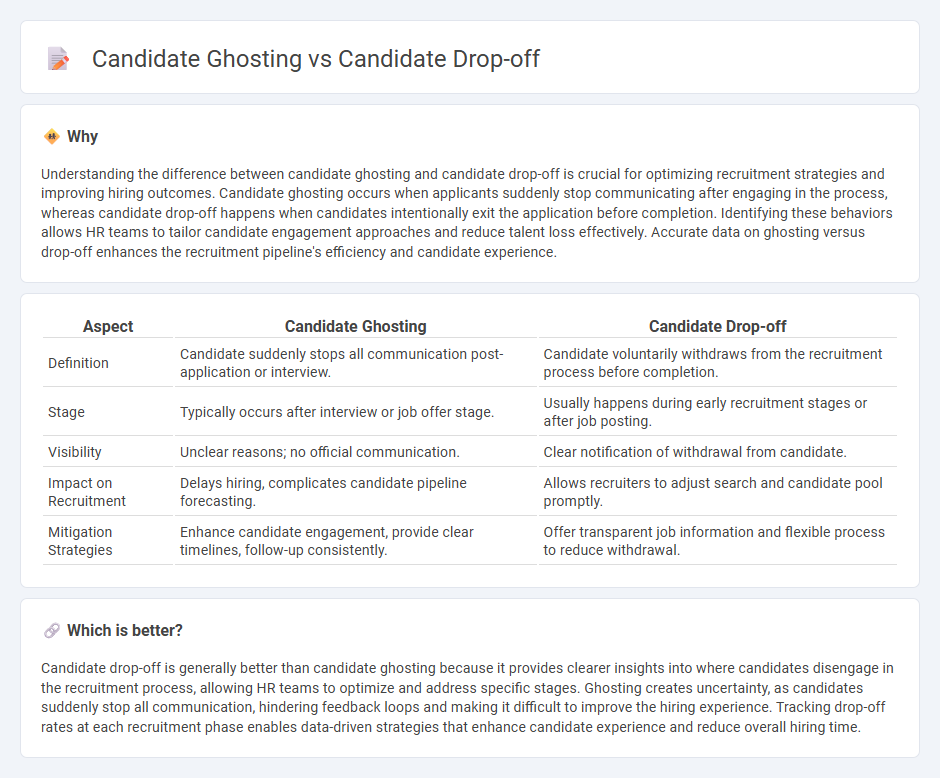
Candidate ghosting occurs when job applicants suddenly stop responding during the hiring process, leaving employers without closure, while candidate drop-off refers to prospects who exit the application or interview stages voluntarily, often due to lengthy procedures or lack of engagement. Both phenomena challenge talent acquisition efforts by increasing time-to-hire and reducing candidate quality. Discover strategies to minimize ghosting and drop-offs to enhance your recruitment success.
Why it is important
Understanding the difference between candidate ghosting and candidate drop-off is crucial for optimizing recruitment strategies and improving hiring outcomes. Candidate ghosting occurs when applicants suddenly stop communicating after engaging in the process, whereas candidate drop-off happens when candidates intentionally exit the application before completion. Identifying these behaviors allows HR teams to tailor candidate engagement approaches and reduce talent loss effectively. Accurate data on ghosting versus drop-off enhances the recruitment pipeline's efficiency and candidate experience.
Comparison Table
| Aspect | Candidate Ghosting | Candidate Drop-off |
|---|---|---|
| Definition | Candidate suddenly stops all communication post-application or interview. | Candidate voluntarily withdraws from the recruitment process before completion. |
| Stage | Typically occurs after interview or job offer stage. | Usually happens during early recruitment stages or after job posting. |
| Visibility | Unclear reasons; no official communication. | Clear notification of withdrawal from candidate. |
| Impact on Recruitment | Delays hiring, complicates candidate pipeline forecasting. | Allows recruiters to adjust search and candidate pool promptly. |
| Mitigation Strategies | Enhance candidate engagement, provide clear timelines, follow-up consistently. | Offer transparent job information and flexible process to reduce withdrawal. |
Which is better?
Candidate drop-off is generally better than candidate ghosting because it provides clearer insights into where candidates disengage in the recruitment process, allowing HR teams to optimize and address specific stages. Ghosting creates uncertainty, as candidates suddenly stop all communication, hindering feedback loops and making it difficult to improve the hiring experience. Tracking drop-off rates at each recruitment phase enables data-driven strategies that enhance candidate experience and reduce overall hiring time.
Connection
Candidate ghosting and candidate drop-off are interconnected issues in human resources recruitment, both reflecting disengagement during the hiring process. Ghosting occurs when candidates suddenly stop responding to communication, while drop-off refers to candidates abandoning the application or interview stages. These phenomena highlight critical challenges in maintaining candidate engagement and ensuring a seamless recruitment experience.
Key Terms
Application Abandonment
Candidate drop-off refers to applicants who begin but do not complete the job application process, often due to lengthy forms or poor user experience. Candidate ghosting occurs when candidates who have engaged with the recruitment process suddenly stop responding or attending interviews. To reduce application abandonment and improve hiring efficiency, explore strategies to streamline applications and enhance candidate engagement. Learn more about optimizing your recruitment funnel.
Interview No-show
Interview No-show rates significantly contribute to both candidate drop-off and ghosting, impacting recruitment efficiency and hiring timelines. Candidate drop-off often occurs when applicants withdraw from the process due to negative experience or poor communication, while ghosting involves candidates ceasing all contact without notice. Explore effective strategies to reduce Interview No-shows and improve candidate engagement throughout the hiring process.
Communication Silence
Candidate drop-off occurs when applicants discontinue the recruitment process by not completing required steps, while candidate ghosting happens when candidates suddenly stop responding during ongoing communication. Both phenomena significantly hinder hiring efficiency and can lead to extended vacancies and increased recruitment costs. Explore strategies to improve communication and reduce silence in hiring by learning more about addressing candidate drop-off and ghosting.
Source and External Links
What is Candidate Drop-Off and How to Mitigate Drop-offs? - This article discusses candidate drop-off as a phenomenon where candidates exit the recruitment process, often due to lack of information, lengthy application processes, poor communication, or uncompetitive compensation.
Top Ways to Reduce Candidate Drop off in Your Hiring Pipeline - The article provides strategies to reduce candidate drop-off, including simplifying the application process, improving communication, and reducing interview complexity.
Why Are Staffing Firms Struggling with Candidate Drop-Offs? - This blog post explores the challenges staffing firms face with candidate drop-off, highlighting issues like poor candidate experience and long hiring timelines.
 dowidth.com
dowidth.com